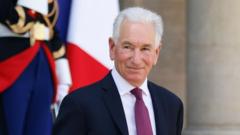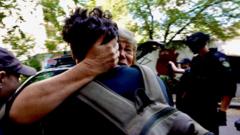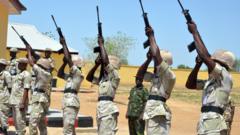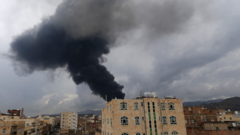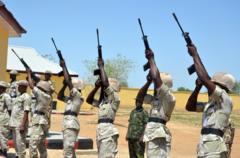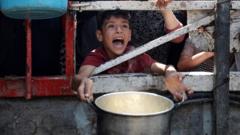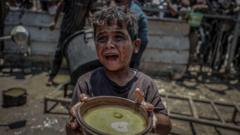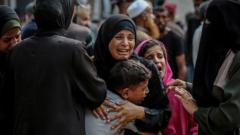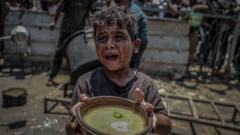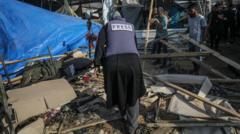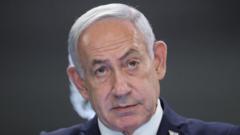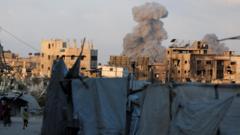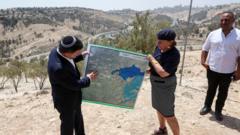Mustafa al Qadri leads a significant aid convoy towards Gaza, symbolizing the support from Jordan and the mounting humanitarian crisis in the region.
Aid Convoys Bring Hope to Gaza Amidst Ongoing Conflict
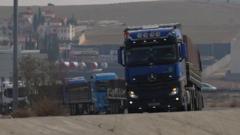
Aid Convoys Bring Hope to Gaza Amidst Ongoing Conflict
Jordan's efforts to deliver urgent aid to Gaza highlight humanitarian solidarity and the dire conditions faced by millions.
In a powerful display of solidarity, Mustafa al Qadri drives an aid convoy to the Gaza Strip under challenging circumstances. Ahead, he looks towards the long row of trucks making their way through the arid Jordan Valley, descending towards Israel and ultimately Gaza. The convoy is set to navigate through Israeli customs at the King Hussein/Allenby Bridge border before reaching the Erez crossing, where the supplies will be handed over to local drivers from the World Food Programme.
Mustafa's mission is fraught with risks, particularly in areas where Israeli settlers obstruct roads and criminal groups hijack aid transport. Yet, pride radiates from him on this bright winter morning as he speaks. "We are carrying aid like food and medication for our brothers in Gaza," he declares, emphasizing a shared kinship that extends beyond mere geography.
In Jordan, Gaza remains a deeply resonant cause. The convoy, consisting of 120 trucks—the largest since the conflict’s escalation—serves as both a lifeline and a message that Gazans have not been forgotten by their neighbors. King Abdullah II of Jordan has spearheaded efforts to facilitate food, medical supplies, and fuel to the beleaguered area, aiming to alleviate the suffering exacerbated by prolonged conflict.
The international community has echoed these sentiments, urging for an urgent and sustained increase in aid deliveries once a ceasefire is firmly established. "The humanitarian situation is at catastrophic levels," warned UN Secretary General Antonio Guterres. With 90% of Gaza's 2.2 million residents displaced and many reliant on aid, the situation is dire.
Witnessing the humanitarian crisis firsthand, a BBC journalist observed weary children standing in line for food in Deir al Balah, highlighting the personal impact of this ongoing war. Ten-year-old Farah Khaled Basal, separated from her father and struggling to support her nine siblings, expressed her longing for a ceasefire. "I want to go back to our home," she shared.
Spotlighting the generational trauma, Lamees Mohammad Al Mizar'i, a 16-year-old who now lives in a tent with her family, reflected on her changed relationship with food amid scarcity. "I used to be picky," she lamented about her past, contrasting it sharply with her current reality of survival.
As more aid prepares to be sent—Jordan’s Hashemite Charity Organisation reports the capability to mobilize 150 trucks each day—the opportunity for humanitarian support remains dependent on the geopolitical landscape. Aid organizations and the UN await the full opening of Gaza to facilitate the much-needed resources, still hopeful for long-term peace in the region.
Mustafa's mission is fraught with risks, particularly in areas where Israeli settlers obstruct roads and criminal groups hijack aid transport. Yet, pride radiates from him on this bright winter morning as he speaks. "We are carrying aid like food and medication for our brothers in Gaza," he declares, emphasizing a shared kinship that extends beyond mere geography.
In Jordan, Gaza remains a deeply resonant cause. The convoy, consisting of 120 trucks—the largest since the conflict’s escalation—serves as both a lifeline and a message that Gazans have not been forgotten by their neighbors. King Abdullah II of Jordan has spearheaded efforts to facilitate food, medical supplies, and fuel to the beleaguered area, aiming to alleviate the suffering exacerbated by prolonged conflict.
The international community has echoed these sentiments, urging for an urgent and sustained increase in aid deliveries once a ceasefire is firmly established. "The humanitarian situation is at catastrophic levels," warned UN Secretary General Antonio Guterres. With 90% of Gaza's 2.2 million residents displaced and many reliant on aid, the situation is dire.
Witnessing the humanitarian crisis firsthand, a BBC journalist observed weary children standing in line for food in Deir al Balah, highlighting the personal impact of this ongoing war. Ten-year-old Farah Khaled Basal, separated from her father and struggling to support her nine siblings, expressed her longing for a ceasefire. "I want to go back to our home," she shared.
Spotlighting the generational trauma, Lamees Mohammad Al Mizar'i, a 16-year-old who now lives in a tent with her family, reflected on her changed relationship with food amid scarcity. "I used to be picky," she lamented about her past, contrasting it sharply with her current reality of survival.
As more aid prepares to be sent—Jordan’s Hashemite Charity Organisation reports the capability to mobilize 150 trucks each day—the opportunity for humanitarian support remains dependent on the geopolitical landscape. Aid organizations and the UN await the full opening of Gaza to facilitate the much-needed resources, still hopeful for long-term peace in the region.

